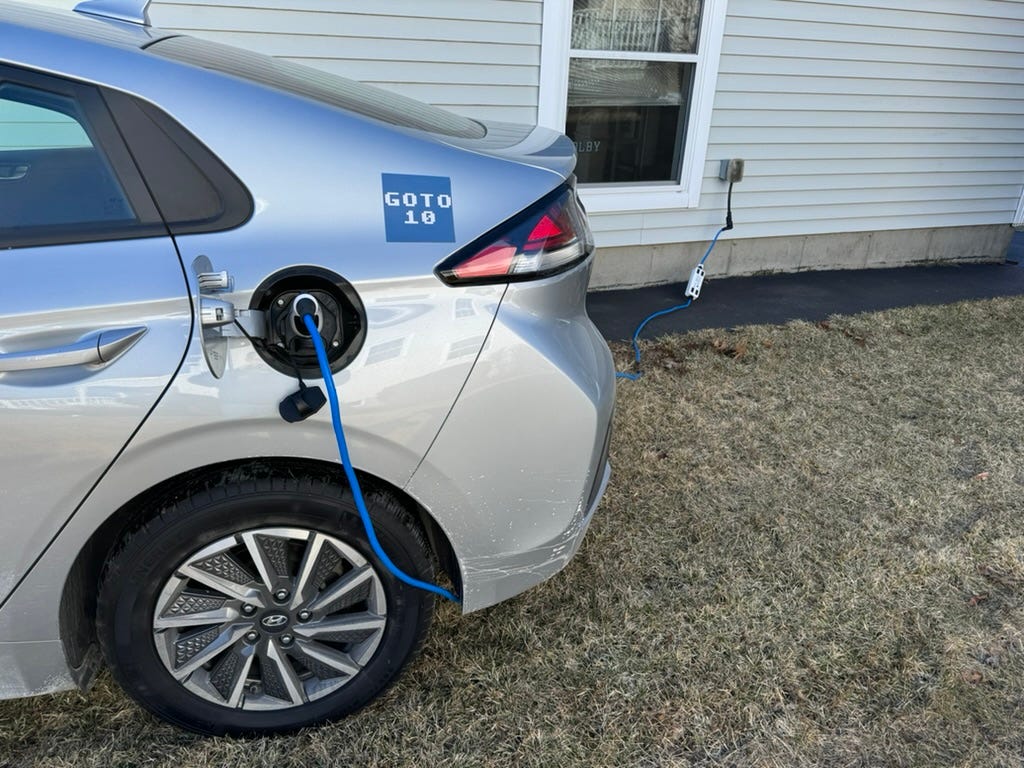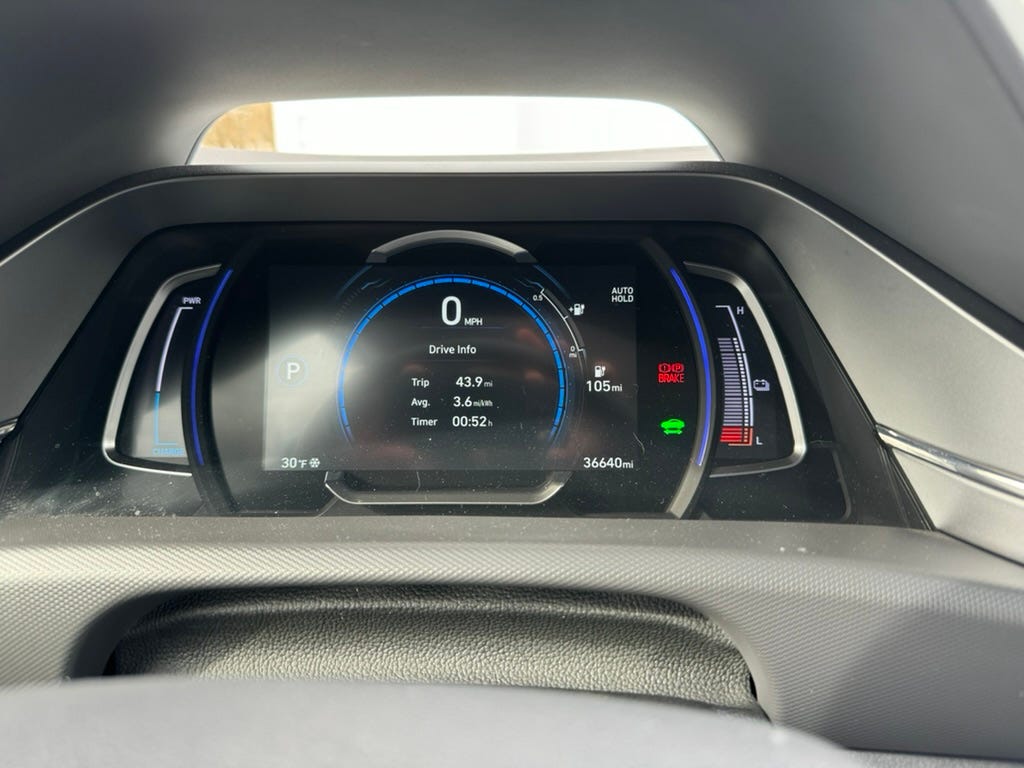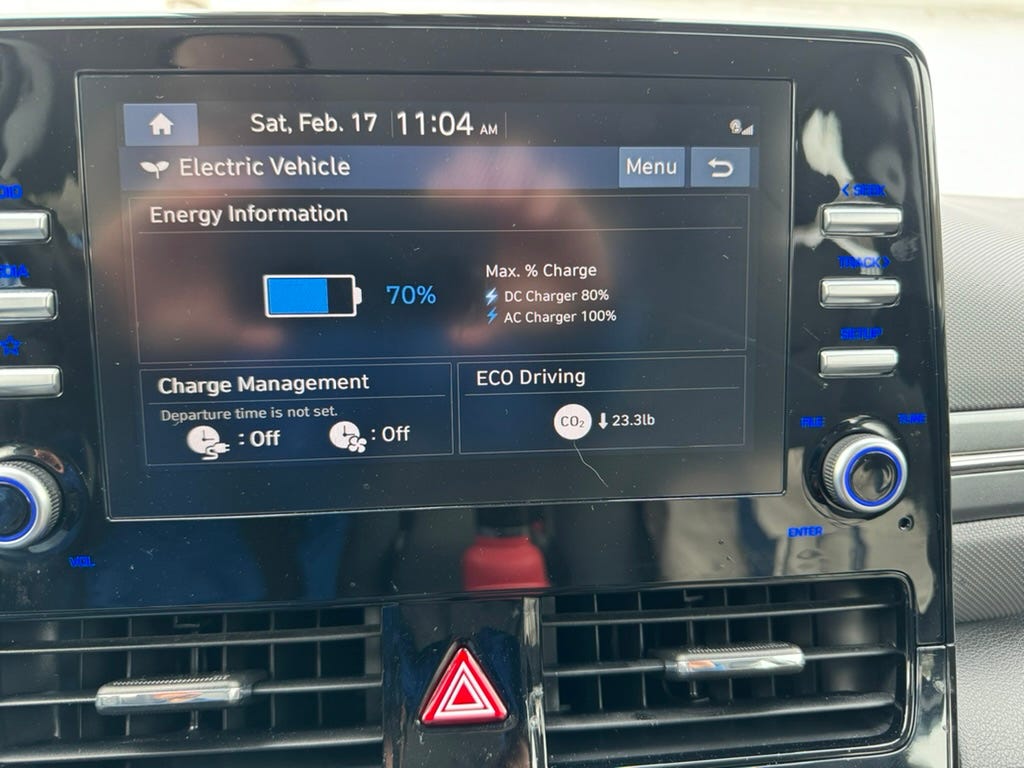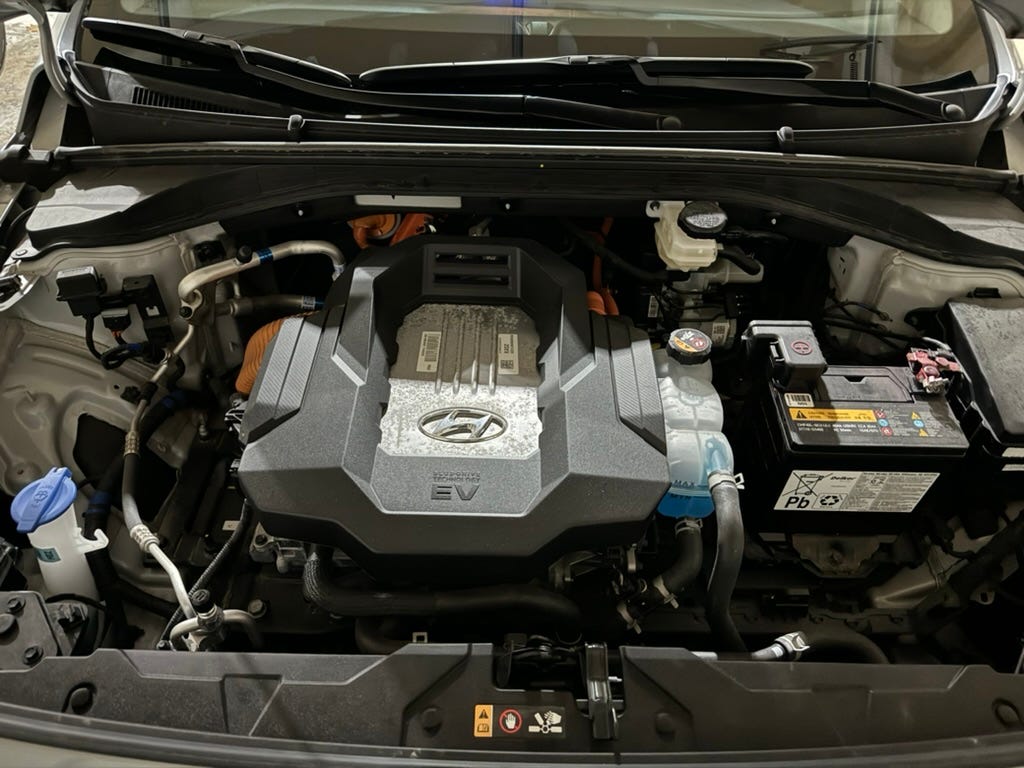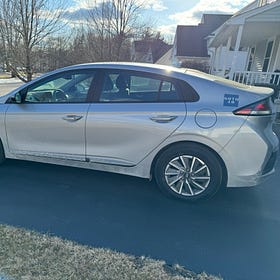As I wrote about in Accidentally Electric, my newly acquired electric vehicle is a 2021 Hyundai Ioniq electric. Going into this, I didn’t know much about this EV, but as more of them are showing up on the used market, I thought it might be worth providing some more insight about it.
The Ioniq was introduced in 2017 with three different models: hybrid electric vehicle (HEV), plug-in hybrid electric vehicle (PHEV) and battery electric vehicle (BEV), which is called the Ioniq electric which is the one I’ll be writing about. The BEV was only sold in a few states in the US, although it was also sold in Canada and most of Europe.
The 2017-2019 models are the first generation and came with a 28kWh battery, good for about 124 miles of range according to the EPA1.
The trim levels varied throughout the US, Canada and Europe. In the US there were two trim levels: SE (base) and Premium (loaded). I’m pretty sure Europe had Premium (base) and Premium SE (loaded), just to be confusing.
In 2020 the Ioniq got several updates. Referred to as the facelift models, the 2020-2021 years got a larger 38.3kWh battery, a slightly different front grill and new interior dash cluster, infotainment and climate controls. One downside is that these newer models have slower DC charging, but that’s not really an issue for me.
Features
I have a 2021 Ioniq SE and that is the one I’ll be mostly writing about, although I’ll touch on differences with others as appropriate. As I have the SE base model, it is missing some features of the Limited, including:
Leather seats
Sunroof
Larger infotainment with navigation
Harmon Kardon premium audio system
Heated steering wheel
Power-folding side mirrors and integrated turn signals
Power driver seat with memory
Rear seat climate vents
LED interior lighting
Rearview mirror with HomeLink
Blind spot collision warning
Rear Cross-Traffic collision warning
The SE does have one thing that the Limited does not: Wireless CarPlay/Android Auto. I’m not sure why the Limited would be missing that feature, but it would seem the upgaded Infotainment system with navigation just doesn’t support it.
In fact, the Ioniq 5 also does not yet have Wireless CarPlay/Android Audio, so go figure.
Since I purchased it used, there were not many options around. There was a 2019 Limited that was available, but it cost quite a bit more and I really wanted the (in my opinion) improved interior and larger battery, even if that has its own limitations I’ll address when I talk about charging.
Overall, the only features I would have really liked from the Limited are the leather seats, LED headlights and upgraded audio system.
Driving
I am amazed at how fun this car is to drive. It is not fast by any means, but it is what I like to call “zippy”. Its 100kW motor (134hp) is not much to brag about, but its 218lb-ft of torque is a lot for such a small car. This car is quick off the line, from 0 to 35mph or so. It tends to drop off a bit after that, but it is certainly much faster than the 2016 Toyota Corolla S that was my previous driver.
More than the speed, my two favorite things are the linear acceleration and the utter silence. I can appreciate the subtle growl of a nice gas engine, but I’ve never been a big engine guy so I really love not hearing any engine sound when I’m accelerating or driving. And the linear, smooth acceleration is easy to get used to. Not having a transmission along with the gear and rev changes really makes for a sublime ride.
Regenerative breaking is the next big change that I have grown to love. Now when I drive one of our GVs (gas vehicles2), I feel like I’m going to drive into something when I forget that they won’t slow down as quickly when I let off the accelerator.
The Ioniq uses flappy paddles on the steering wheel to control the level of regenerative breaking. I have things set at level 2 and don’t usually change it, although I do like to hold the left pedal to come to a complete stop without having to use the brake pedal, which is the Ioniq’s version of 1-pedal driving.
There are several driving modes, including Eco, Normal and Sport. You can also enable Eco+ by holding down the Drive Mode button, but I’ve not tested that. I mostly use Normal, but Sport does tighten up the steering and makes the accelerator more responsive, so I do end up using that a lot around town.
Range
The Ioniq measures its efficiency in miles per kilowatt hour, aka mi/kWh. The range you can get is calculated based on the efficiency multiplied by the kilowatts left in the battery.
For my driving, I’ve so far seen efficiency anywhere from 3.5mi/kWh to 6.1mi/kWh. So if we multiple that out by the 38.3kW battery, we can see that comes out to ranges of about 134 miles to 233 miles. That is quite a wide range!
So far most of my driving has been in winter and early spring and not in any sort of warm weather. Temperatures have been in the range of about 20F to 55F. Electric cars get much better efficiency in the 60F-90F temperature range, so I have to wait another month or so to see if my numbers start improving with the warmer weather. Early indications are that they will.
The efficiency is also affected by the type of driving. Highway driving gives the worst efficiency, especially as the speeds go up. Here in Maine, the highway speeds are mostly 70mph, so I’ve been setting the cruise to about 72mph. If I were to drop it down further, the efficiency would go up.
Efficiency is much higher when driving at slower speeds and around town. Driving on back roads with speeds of 45 or less is where I’ve hit my peak of 6.1mi/kWh.
So far my longest drives are about 100 miles, roundtrip. With anything longer than that, especially if it is mostly highway I will likely need to plan to stop to charge somewhere.
Charging
There are two ways to charge an EV: AC and DC.
When I first got the Ioniq I charged it using the AC level 1 charging cable that it came with. This worked fine, but it was slow as it could only add about 1.3kW to the battery each hour.
I did try a public AC level 2 charging station as a test and it would reach about 6kW. Technically the Ioniq charges at a maximum of 7.2kW on an AC level 2 connection.
I have not yet had a need to try DC charging. This is also called fast charging or DC fast charging because charging happens at much higher rates. In the case of the Ioniq, it’s not that fast, though. With the appropriate DC charging station, the Ioniq can max out at about 50kW.
The older 2017-2019 Ioniqs could DC charge faster, often hitting 70kW or so. With their smaller battery, it can make it feel like they are able to charge much more quickly.
I decided to add a 240 volt outlet in my garage so I could charge at AC level 2. I’ll write more about that in a later post, but it has so far been able to charge the car at a rate of about 5 to 7.2kW, meaning the car usually tops back up in just a few hours.
Quirks and Features
To borrow the terms from car YouTuber Doug DeMuro, the Ioniq does it have its fair share of quirks and features, some of which I’ll cover here.
I have no big problems with the interior, although there is too much glossy black that gets covered in fingerprints. I keep a small microfiber cloth in the center console to shine things up periodically. The gauge cluster has a slight opening into the dash itself at the top, which is odd.
The stereo, even though it is not the Harmon Kardon, sounds pretty good to me. I certainly have enjoyed the new Judas Priest album on it! And wireless CarPlay is just wonderful, although I have had it glitch out a couple times where it refuses to connect for a short while before eventually fixing itself.
I do like the electric information screen that gives you details on range with and without the heat on and how much time it would take to charge based on the type of connections. The Ioniq lets you schedule charging and set a maximum percentage for AC and DC charging.
The Hyundai BlueLink app can be used with their paid services to monitor vehicle status, and control some functions such as charging, climate, locking, location, etc. My free trial expires in July, after which I’ll have to decide if it is worth the $20/month.
I do like the cloth seats and find them comfortable. I love that they are heated with three levels (level 3 gets super-hot). All cars in Maine should be required to come with heated seats and I really missed them on the Corolla.
I absolutely love having a hatchback. It is so much more practical than a sedan. Plus, Lucy loves hanging out back there on car rides.
Speaking of the hatch area, the split rear window that you can see in the photo above is definitely a big quirk. The bar in the middle can obscure things a bit, but I quickly got used to it. Because of the bar and the different angles of the windows, there is also no rear wiper which is more of a pain as those two windows can collect a lot of rain and grime. I’ve heavily coated them with Rain-X to work around that problem.
There is no frunk (front trunk) in the Ioniq, although have a found a company that sells a small one that can replace the cover that is in the engine bay.
The Ioniq does have a utility mode that lets you have the car turned on, but unable to drive. This allows you to run the heat and all its functions, so it could serve as a “camping mode” for the EV. With the seats folded down, you can spread out a sleeping bag into the hatch area and run heat (or AC) overnight.
Since some have asked me, running the heat uses about 1kWh, so with a full battery it could have the heat running for over 30 hours.
Conclusion
I’ll have more to write about the Ioniq in the coming months, but so far I absolutely love it. I’m again looking for any excuse to go for a drive, something which had left me when I primarily drove the rather boring Corolla.
If you’re interested, below is a PDF of the 2021 Ioniq sales brochure.
You might also like:
Accidentally Electric
EPA range estimates are not all that useful, to be honest. I’ll be writing a future post about that.
I realize that ICE (Internal Combustion Engine) is the common term used to refer to gas-powered cars, I prefer GV as it matches nicely with EV and doesn’t sound as condescending as ICE.




